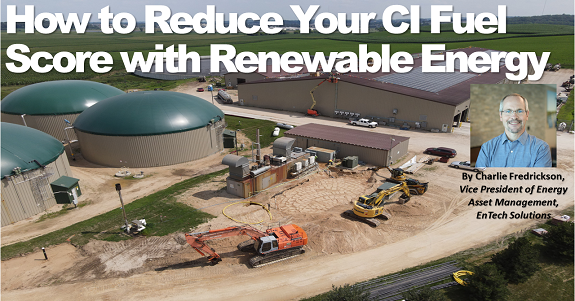How to Reduce Your CI Fuel Score with Renewable Energy

By Charlie Fredrickson, Vice President of Energy Asset Management, EnTech Solutions
Special to The Digest
Facilities that produce low-carbon fuels to sell credits within the Low Carbon Fuel Standard (LCFS) program face ever-increasing benchmarks to reduce their carbon intensity (CI) scores to maximize revenue. In the production of these low carbon fuels such as renewable natural gas (RNG), biofuels, hydrogen, ethanol and alternative jet fuel, clean energy microgrids bring a new dimension to the business case for the addition of a microgrid or distributed energy resource to a production facility.
How Does the LCFS Program Relate to CI Scores?
The LCFS program creates a market to buy and sell credits generated from fuel production under the established CI benchmark. The goal of this program is to reduce greenhouse gases created during the production and use of transportation fuels and promote the development and production of low-carbon and renewable alternatives. To reduce a fuel’s CI score, all areas of production and fuel consumption need to be addressed. Using clean energy in the production of renewable natural gas (RNG) is one way to reduce the CI score.
There are various strategies to achieve the goals of the LCFS program, along with financial benefits producers will realize by meeting CI reduction goals. As the CI reduction target declines 20 percent by 2030, it will drive producers to leverage more technologies to meet or beat these yearly goals to stay competitive. There are a few factors that a producer can act on to stay ahead of this curve; one of them is the utilization of renewable energy, as energy consumption at a production facility is a contributor to CI scores. Many producers will use RNG to power their facilities. However, with the high value of RNG on today’s open market, other sources like wind and solar via a microgrid can make a more significant financial impact while allowing you to maximize profits by selling the RNG produced.
How Wind and Solar Microgrids Can Support CI Reduction
Each facility has its own unique CI score for electricity or natural gas consumption. Each point of CI reduction will result in additional revenue for the producer; this can be anywhere from 2 to 8 percent. To maximize the reduction of its CI score, the facility must produce and consume its own on-site clean energy, with a direct connection from the clean energy asset into the facility. Depending on the facility location and land available, this energy could come from wind or solar. Balancing on-site clean energy-generating assets with energy storage and energy management is best handled by an intelligent microgrid that works in tandem with the production facility to optimize the clean energy produced for CI reduction. An additional strategy for CI reduction is adding an electric boiler that operates during peak clean energy production days. Limiting the use of gas boilers further helps CI reduction.
How To Reduce Waste and Emissions Using Creativity
In 2020, EnTech Solutions formed a joint venture with Northern Biogas LLC to acquire an active biogas facility in the Town of Springfield, Dane County, Wisconsin. This facility showcases a model for a sustainable energy future as EnTech Solutions performed renovations to reduce its CI score and maximize the value of the RNG for the LCFS program.
To reduce the RNG CI score, EnTech Solutions integrated distributed energy technology to produce clean energy power for the site. EnTech’s DCentrIQ microgrid platform, which includes batteries and inverters, is paired with solar panels, adding more than 2.8 MW of clean energy – the equivalent of powering more than 400 homes. The microgrid operates on power generated from solar panels, storing excess energy in the battery system to optimize renewable energy utilization. When solar power is unavailable due to cloud cover or at night, it uses power from the battery system or the grid, providing resilient power. The distributed energy system is monitored remotely through the EnTech Energy Center, which provides instantaneous performance information with built-in intelligence, prioritizing all assets in real time to ensure the facility is receiving the highest value, least expensive and most reliable electricity from all available energy sources.
The microgrid allows the operations of the facility to be run using clean energy, lowering the facility’s CI score and maximizing revenue, so they can focus on the production of RNG:
- EnTech Solutions partners with local dairy farms within the county to collectively process manure from more than 4,000 cows in three air-tight digester tanks. The tank temperatures are maintained at around 100 degrees Fahrenheit, creating an environment where microbes thrive and consume the volatile solids in the manure while producing methane gas (biogas).
- Instead of releasing that methane into the atmosphere, the biogas is captured at the top of the digester and combusted in generators to create about 14.4 million kilowatt-hours of electricity per year. In early 2022, that same methane will be processed into RNG to offset dependence on fossil-fuel-based natural gas, reducing emissions by more than 11,000 metric tons of carbon dioxide equivalent per year.
- The facility provides more benefits to the regional ecosystem by utilizing advanced filtration technology by Aqua Innovationsto remove phosphorus from the watershed.
EnTech Solutions’ experience transforming the operations for this biodigester uniquely positions them to help other biogas producers take the next step allowing for optimization of their operations.
The one constant in the clean energy industry is change. The bar will continually move to reduce greenhouse gas emissions, driving innovation and advancements in technology to optimize clean energy resources.

Category: Thought Leadership, Top Stories















